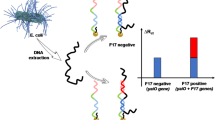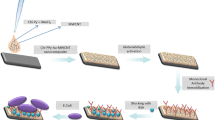Abstract
Pathogenic bacteria can cause the outbreaks of disease and threaten human health, which stimulates the development of advanced detection techniques. Herein, a specific and sensitive electrochemical biosensor for Gram-negative bacteria was established based on the conductive polymer with artificial muscle properties. The effective recognition was achieved through the specific carbohydrate-carbohydrate interaction between gluconamide and lipopolysaccharide. The application of impulse voltage enhances the efficiency of recognition and shortens the detection time through the temporary deformation of the electrode surface, with a limit of detection (LOD) of 1 × 100 CFU/mL and a linear range of 1 × 100 − 1 × 106 CFU/mL for Escherichia coli (E. coli). In addition to the merits of low cost, high efficiency, and rapidity, the developed label-free electrochemical biosensor can also be applicable for other Gram-negative bacteria, owning promising potential in the application of portable devices and paving a potential way for the construction of electrochemical biosensors.
Graphical abstract







Similar content being viewed by others
References
Imai Y, Meyer KJ, Iinishi A, Favre−Godal Q, Green R, Manuse S, Caboni M, Mori M, Niles S, Ghiglieri M, Honrao C, Ma XY, Guo JJ, Makriyannis A, Linares−Otoya L, Bohringer N, Wuisan ZG, Kaur H, Wu RR, Mateus A, Typas A, Savitski MM, Espinoza JL, O’Rourke A, Nelson KE, Hiller S, Noinaj N, Schaberle TF, D’Onofrio A, Lewis K, (2020) A new antibiotic selectively kills Gram-negative pathogens. Nature 580:E3–E3
Oh JM, Venters CC, Di C, Pinto AM, Wan LL, Younis I, Cai ZQ, Arai C, So BR, Duan JQ, Dreyfuss G (2020) U1 snRNP regulates cancer cell migration and invasion in vitro. Nat Commun 11:1
Denamur E, Clermont O, Bonacorsi S, Gordon D (2021) The population genetics of pathogenic Escherichia coli. Nat Rev Microbiol 19:37–54
Croxen MA, Finlay BB (2010) Molecular mechanisms of Escherichia coli pathogenicity. Nat Rev Microbiol 8:26–38
Furst AL, Francis MB (2018) Impedance-based detection of bacteria. Chem Rev 119:700–726
Sender R, Fuchs S, Milo R (2016) Are we really vastly outnumbered? Revisiting the ratio of bacterial to host cells in humans. Cell 164:337–340
Chen F, Kim S, Na J, Han K, Lee TY (2020) A single-tube sample preparation method based on a dual-electrostatic interaction strategy for molecular diagnosis of gram-negative bacteria. Microchim Acta 187:558
Shin S, Jung Y, Uhm H, Song M, Son S, Goo J, Jeong C, Song JJ, Kim VN, Hohng S (2020) Quantification of purified endogenous miRNAs with high sensitivity and specificity. Nat Commun 11:6033
Besant JD, Sargent EH, Kelley SO (2015) Rapid electrochemical phenotypic profiling of antibiotic-resistant bacteria. Lab Chip 15:2799–2807
Gao X, Yin YL, Wu HT, Hao Z, Li JJ, Wang S, Liu YQ (2021) Integrated SERS platform for reliable detection and photothermal elimination of bacteria in whole blood samples. Anal Chem 93:1569–1577
Zhu YD, Gasilova N, Jovic M, Qiao L, Liu BH, Lovey LT, Pick H, Girault HH (2018) Detection of antimicrobial resistance-associated proteins by titanium dioxide-facilitated intact bacteria mass spectrometry. Chem Sci 9:2212–2221
Zhao Y, Hu XG, Hu S, Peng Y (2020) Applications of fiber-optic biochemical sensor in microfluidic chips: a review. Biosens Bioelectron 166:112447
VanArsdale E, Tsao CY, Liu Y, Chen CY, Payne GF, Bentley WE (2019) Redox-based synthetic biology enables electrochemical detection of the herbicides dicamba and roundup via rewired Escherichia coli. ACS Sens 4:1180–1184
Zhang J, Jiang Y, Xia X, Wu J, Almeida R, Eda S, Qi HC (2020) An on-site, highly specific immunosensor for Escherichia coli detection in field milk samples from mastitis-affected dairy cattle. Biosens Bioelectron 165:112366
Nezakati T, Seifalian A, Tan A, Seifalian AM (2018) Conductive polymers: opportunities and challenges in biomedical applications. Chem Rev 118:6766–6843
Chowdhury AD, Takemura K, Li TC, Suzuki T, Park EY (2019) Electrical pulse-induced electrochemical biosensor for hepatitis E virus detection. Nat Commun 10:3737
Shi Y, Peng LL, Ding Y, Zhao Y, Yu GH (2015) Nanostructured conductive polymers for advanced energy storage. Chem Soc Rev 44:6684–6696
Rojas ER, Billings G, Odermatt PD, Auer GK, Zhu L, Miguel A, Chang F, Weibel DB, Theriot JA, Huang KC (2018) The outer membrane is an essential load-bearing element in Gram-negative bacteria. Nature 559:617−+
Vetterli SU, Zerbe K, Muller M, Urfer M, Mondal M, Wang SY, Moehle K, Zerbe O, Vitale A, Pessi G, Eberl L, Wollscheid B, Robinson JA (2018) Thanatin targets the intermembrane protein complex required for lipopolysaccharide transport in Escherichia coli. Sci Adv 4:eaau2634
Capeletti LB, de Oliveira JFA, Loiola LMD, Galdino FE, Santos DED, Soares TA, Freitas RD, Cardoso MB (2019) Gram-negative bacteria targeting mediated by carbohydrate–carbohydrate interactions induced by surface-modified nanoparticles. Adv Funct Mater 29:1904216
Xu J, Qu KZ, Zhao JJ, Jian XX, Gao ZD, Xu JW, Song YY (2020) In situ monitoring of the “point discharge” induced antibacterial process by the onsite formation of a Raman probe. Anal Chem 92:2323–2330
Nguyen TD, Pham MC, Piro B, Aubard J, Takenouti H, Keddam M (2004) Conducting polymers and corrosion PPy - PPy-PDAN composite films - electrosynthesis and characterization. J Electrochem Soc 151:B325–B330
Wang YB, Iqbal Z, Mitra S (2006) Rapidly functionalized, water-dispersed carbon nanotubes at high concentration. J Am Chem Soc 128:95–99
Bai MH, Bian LJ, Song Y, Liu XX (2014) Electrochemical codeposition of vanadium oxide and polypyrrole for high-performance supercapacitor with high working voltage. ACS Appl Mater Interfaces 6:12656–12664
Devi S, Kaur R, Paul AK, Tyagi S (2018) MPA-capped CdSe QD/mercaptoethylamine-capped AuNP nanocomposite-based sensor for instant detection of trinitrotoluene. Colloid Polym Sci 296:427–440
Siebner−Freibach H, Hadar Y, Yariv S, Lapides I, Chen Y, (2006) Thermospectroscopic study of the adsorption mechanism of the hydroxamic siderophore ferrioxamine B by calcium montmorillonite. J Agric Food Chem 54:1399–1408
Gangopadhyay R, Chowdhury AD, De A (2012) Functionalized polyaniline nanowires for biosensing. Sens Actuators B Chem 171:777–785
Just PE, Chane-Ching KI, Lacroix JC, Lacaze PC (2001) Electrochemical oxidation of dipyrrolyl derivatives: application to the formation of reticulated conducting polymers with conjugated spacers. Electrochim Acta 46:3279–3285
Pethig R, Markx GH (1997) Applications of dielectrophoresis in biotechnology. Trends Biotechnol 15:426–432
Lundstedt E, Kahne D, Ruiz N (2020) Assembly and maintenance of lipids at the bacterial outer membrane. Chem Rev 121:5098–5123
Hampton RY, Raetz CRH (1991) Macrophage catabolism of lipid A is regulated by endotoxin stimulation. J Biol Chem 266:19499–19509
Acknowledgements
Special thanks are due to the instrument or data analysis from Analytical and Testing Center, Northeastern University.
Funding
This work was supported by the National Natural Science Foundation of China (No. 21775016, 21874013, and 22074013), the Fundamental Research Funds for the Central Universities (N2005027, N2105018, N180504006), and Talent Project of Revitalizing Liaoning (XLYC1807165).
Author information
Authors and Affiliations
Corresponding author
Additional information
Publisher's note
Springer Nature remains neutral with regard to jurisdictional claims in published maps and institutional affiliations.
Supplementary Information
Below is the link to the electronic supplementary material.
604_2021_5073_MOESM1_ESM.docx
Supplementary file1 (DOCX 4413 kb) Additional information about SEM spectra, LSCFM images, Water contact angle images, Zeta potential, EIS and CV plots, and optimization of experimental conditions were listed in supporting information.
Rights and permissions
About this article
Cite this article
Ren, S., Zhang, X., Li, Z. et al. Development of a pulse-induced electrochemical biosensor based on gluconamide for Gram-negative bacteria detection. Microchim Acta 188, 399 (2021). https://doi.org/10.1007/s00604-021-05073-9
Received:
Accepted:
Published:
DOI: https://doi.org/10.1007/s00604-021-05073-9




